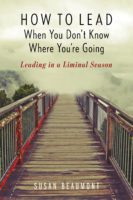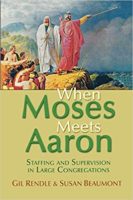
Much of our decision making over the past two years has been reactive. Continually shifting COVID protocols, political polarization, and local and global turmoil leave us feeling fragmented. You may be wondering whether you have been strategic enough. Has your preoccupation with managing the chaos prevented you from pursuing mission, vision, and intentional innovation? Cultivating six habits can help you get strategically reoriented now.
I have noticed a common default response among leaders who shake free of crisis management and turn their attention to strategy. The most common impulse is to create a strategic plan. Revise the mission and vision statements, declare new strategic priorities, and create action plans. Get everybody on the same page. Strategic plans have their place, but they should not be our default response to disorientation.
Strategy as learning
Thinking strategically is not the same thing as planning systematically. Strategic planning is just one way that strategy emerges in an organization. In liminal seasons like this one, it is important for leaders to appreciate the nonlinear nature of most real strategy.
The research of strategy theorist Henry Mintzberg showed that 90% of projected outcomes in formal strategic planning processes never materialize. Only 10% of organizational action arises out of formal plans. Instead, 90% of what organizations really do can be defined as emergent strategy. This is the accumulation of day-to-day decision making, disjointed initiatives, and actions taken by leaders in response to everyday demands—without a grand master plan.
Perhaps our aim should be to better shape emergent strategy, to increase the odds of meaningful, mission-driven action, rather than random, happenstance chaos. This is where strategic thinking comes into play.
Strategic thinking is the skill set we use to shape emergent strategy. To help the organization adapt and change in new directions and to propel innovation. Strategic thinking relies on intuition, reflection, authentic dialogue, and the confrontation of unstated assumptions.
Six Habits to Cultivate
No one is born knowing how to think strategically. No one is fully proficient as a strategic thinker. The requisite skills come more easily to some than others, but we can all become more effective as strategic thinkers. Here are six important habits to cultivate, adapted from the work of Julia Sloan in Learning to Think Strategically.
1. Appreciate but Challenge Tacit Knowledge.
Tacit knowledge is knowing in action. It is the muscle memory of intuitive decision making. It comes from the accumulated experience, learned skills, and successful repetition of all that has gone before. Tacit knowledge is useful when we need to be decisive in the face of uncertainty.
Tacit knowledge is problematic when we let outdated assumptions guide our decision making—when we simply repeat the past without correcting for emergent trends.
Becoming a better strategic thinker requires a healthy respect for the power of unstated assumptions. Develop the habit of pausing to reflect on the unstated assumptions that have formed your intuition. “Our dialogue about getting people to return to in-person worship assumes that people who haven’t returned are fearful of the virus. Is that still an appropriate assumption?”
2. Pay Attention to Patterns and Challenge Framing.
Pattern recognition is an automatic process of making sense. We see a set of clues that appear together, we assume what is present, and we project what will happen next based on experience. Pattern recognition can lead to decision making without critical analysis.
Innovation requires turning off the autopilot of pattern recognition and investing in critical reflection. Pause and restate the problem from a different perspective. Explore how the problem emerged, look at progression and sequence of events. Physically map actions and reactions. Name the values in tension. Inquire about the relevance of the problem.
3. Poke Around Until You Find the Surprise
Penetrate deeper into the core of the thing that seems different.
Sit patiently with evidence that doesn’t fit easily into previous patterns. Look for untapped opportunities.
Set aside your need to feel in control of the situation. Set aside whatever opinions you have already formed about what needs to happen next. Sit with your experience from a place of humility and patience, being open to what wants to emerge.
Slow down so that you can notice more. Relax and play and reflect.
4. Diversify and Upgrade Your Verbal Engagement
Notice the type of verbal engagement that you and others use when talking about your challenges. Is it worry-filled grumbling? Pessimistic projection? Circuitous discussion that goes nowhere?
Introduce alternative forms of conversation. Practice using appreciative inquiry—the art of asking about and exploring the positive core. Bring an appreciative perspective to your analysis of the current challenge.
Or set up an organized debate among leaders, with a carefully defined problem statement and guidelines for debate.
Alternatively, frame the challenge through the lens of dialogue. Dialogue involves carefully constructed conversational norms that allow us to set aside fears, preconceptions and the need to win. We take time to hear other voice and possibilities.
Enriching the diversity in the room invites deeper verbal engagement. Be intentional about drawing in outside perspectives. Train yourself to ask, “Who needs to be in this conversation that isn’t currently in the room?”
5. Get Out of Your Head
Record as many of your thoughts, feelings, and new questions as possible in a journal or log. This is a useful way to begin identifying patterns, uncover assumptions and highlight traps in your thinking.
Sit with the feelings attached to your thinking. Reflect on the feelings that provoke questions or lead to other strong feelings.
Consider drawing or shaping your strategies instead of writing them. Use color or shape codes to identify themes.
Tell parables or formulate analogies that illustrate your assumptions and beliefs about what is happening.
6. Find a Thought Partner
Find listeners and questioners who don’t know the background, the content, or the politics of your strategic challenge. Ask them to listen to you present the issue and invite them to name unstated assumptions, patterns, or frames that you have missed or taken for granted. Find yourself a peer group or a mentor. Invest in a coaching relationship.
We seem to be entering a new season, one that will require more strategic thinking and deeper critical reflection. This will require examining old assumptions, recognizing new patterns, and responding with fresh perspective. The time is ripe for layering in new habits. God is up to something new, and we need strategic approaches to embrace all that is arising.
Susan Beaumont is a coach, educator, and consultant who has worked with hundreds of faith communities across the United States and Canada. Susan is known for working at the intersection of organizational health and spiritual vitality. She specializes in large church dynamics, staff team health, board development, and leadership during seasons of transition.
With both an M.B.A. and an M.Div., Susan blends business acumen with spiritual practice. She moves naturally between decision-making and discernment, connecting the soul of the leader with the soul of the institution. You can read more about her ministry at susanbeaumont.com.



